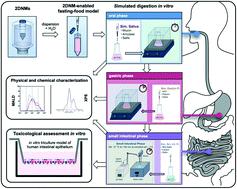当前位置:
X-MOL 学术
›
Environ. Sci.: Nano
›
论文详情
Our official English website, www.x-mol.net, welcomes your
feedback! (Note: you will need to create a separate account there.)
Biotransformations and cytotoxicity of graphene and inorganic two-dimensional nanomaterials using simulated digestions coupled with a triculture in vitro model of the human gastrointestinal epithelium
Environmental Science: Nano ( IF 5.8 ) Pub Date : 2021-10-08 , DOI: 10.1039/d1en00594d Lila Bazina 1 , Dimitrios Bitounis 1 , Xiaoqiong Cao 1 , Glen M DeLoid 1 , Dorsa Parviz 2 , Michael S Strano 2 , Hao-Yu Greg Lin 3 , David C Bell 3, 4 , Brian D Thrall 5 , Philip Demokritou 1
Environmental Science: Nano ( IF 5.8 ) Pub Date : 2021-10-08 , DOI: 10.1039/d1en00594d Lila Bazina 1 , Dimitrios Bitounis 1 , Xiaoqiong Cao 1 , Glen M DeLoid 1 , Dorsa Parviz 2 , Michael S Strano 2 , Hao-Yu Greg Lin 3 , David C Bell 3, 4 , Brian D Thrall 5 , Philip Demokritou 1
Affiliation

|
Background: engineered nanomaterials (ENMs) have already made their way into myriad applications and products across multiple industries. However, the potential health risks of exposure to ENMs remain poorly understood. This is particularly true for the emerging class of ENMs know as 2-dimensional nanomaterials (2DNMs), with a thickness of one or a few layers of atoms arranged in a planar structure. Methods: the present study assesses the biotransformations and in vitro cytotoxicity in the gastrointestinal tract of 11 2DNMs, namely graphene, graphene oxide (GO), partially reduced graphene oxide (prGO), reduced graphene oxide (rGO), hexagonal boron nitride (h-BN), molybdenum disulphide (MoS2), and tungsten disulphide (WS2). The evaluated pristine materials were either readily dispersed in water or dispersed with the use of a surfactant (Na-cholate or PF108). Materials dispersed in a fasting food model (FFM, water) were subjected to simulated 3-phase (oral, gastric, and small intestinal) digestion to replicate the biotransformations that would occur in the GIT after ingestion. A triculture model of small intestinal epithelium was used to assess the effects of the digested products (digestas) on epithelial layer integrity, cytotoxicity, viability, oxidative stress, and initiation of apoptosis. Results: physicochemical characterization of the 2DNMs in FFM dispersions and in small intestinal digestas revealed significant agglomeration by all materials during digestion, most prominently by graphene, which was likely caused by interactions with digestive proteins. Also, MoS2 had dissolved by ∼75% by the end of simulated digestion. Other than a low but statistically significant increase in cytotoxicity observed with all inorganic materials and graphene dispersed in PF108, no adverse effects were observed in the exposed tricultures. Conclusions: our results suggest that occasional ingestion of small quantities of 2DNMs may not be highly cytotoxic in a physiologically relevant in vitro model of the intestinal epithelium. Still, their inflammatory or genotoxic potential after short- or long-term ingestion remains unclear and needs to be studied in future in vitro and in vivo studies. These would include studies of effects on co-ingested nutrient digestion and absorption, which have been documented for numerous ingested ENMs, as well as effects on the gut microbiome, which can have important health implications.
中文翻译:

使用模拟消化与人胃肠道上皮体外三培养模型相结合的石墨烯和无机二维纳米材料的生物转化和细胞毒性
背景:工程纳米材料(ENM)已经进入多个行业的无数应用和产品。然而,人们对接触 ENM 的潜在健康风险仍知之甚少。对于被称为二维纳米材料 (2DNM) 的新兴 ENM 来说尤其如此,其厚度为一层或几层原子排列成平面结构。方法:本研究评估了 11 种 2DNM 在胃肠道中的生物转化和体外细胞毒性,即石墨烯、氧化石墨烯(GO)、部分还原氧化石墨烯(prGO)、还原氧化石墨烯(rGO)、六方氮化硼(h- BN)、二硫化钼(MoS 2 )和二硫化钨(WS 2 )。所评估的原始材料要么很容易分散在水中,要么使用表面活性剂(胆酸钠或PF108)进行分散。将分散在空腹食物模型(FFM、水)中的材料进行模拟三相(口腔、胃和小肠)消化,以复制摄入后胃肠道中发生的生物转化。小肠上皮的三培养模型用于评估消化产物(消化物)对上皮层完整性、细胞毒性、活力、氧化应激和细胞凋亡起始的影响。结果:FFM 分散体和小肠消化液中 2DNM 的物理化学特征表明,消化过程中所有材料均发生显着团聚,其中石墨烯最为突出,这可能是由与消化蛋白相互作用引起的。 此外,在模拟消化结束时,MoS 2已溶解约 75%。除了分散在 PF108 中的所有无机材料和石墨烯观察到的细胞毒性较低但具有统计显着性增加外,在暴露的三培养物中没有观察到任何不利影响。结论:我们的结果表明,在生理相关的体外肠上皮模型中,偶尔摄入少量 2DNM 可能不会产生高度细胞毒性。尽管如此,短期或长期摄入后它们的炎症或遗传毒性潜力仍不清楚,需要在未来的体外和体内研究中进行研究。这些研究包括对共同摄入的营养物质消化和吸收的影响的研究(已针对大量摄入的 ENM 进行了记录),以及对肠道微生物组的影响(这可能对健康产生重要影响)。
更新日期:2021-10-15
中文翻译:

使用模拟消化与人胃肠道上皮体外三培养模型相结合的石墨烯和无机二维纳米材料的生物转化和细胞毒性
背景:工程纳米材料(ENM)已经进入多个行业的无数应用和产品。然而,人们对接触 ENM 的潜在健康风险仍知之甚少。对于被称为二维纳米材料 (2DNM) 的新兴 ENM 来说尤其如此,其厚度为一层或几层原子排列成平面结构。方法:本研究评估了 11 种 2DNM 在胃肠道中的生物转化和体外细胞毒性,即石墨烯、氧化石墨烯(GO)、部分还原氧化石墨烯(prGO)、还原氧化石墨烯(rGO)、六方氮化硼(h- BN)、二硫化钼(MoS 2 )和二硫化钨(WS 2 )。所评估的原始材料要么很容易分散在水中,要么使用表面活性剂(胆酸钠或PF108)进行分散。将分散在空腹食物模型(FFM、水)中的材料进行模拟三相(口腔、胃和小肠)消化,以复制摄入后胃肠道中发生的生物转化。小肠上皮的三培养模型用于评估消化产物(消化物)对上皮层完整性、细胞毒性、活力、氧化应激和细胞凋亡起始的影响。结果:FFM 分散体和小肠消化液中 2DNM 的物理化学特征表明,消化过程中所有材料均发生显着团聚,其中石墨烯最为突出,这可能是由与消化蛋白相互作用引起的。 此外,在模拟消化结束时,MoS 2已溶解约 75%。除了分散在 PF108 中的所有无机材料和石墨烯观察到的细胞毒性较低但具有统计显着性增加外,在暴露的三培养物中没有观察到任何不利影响。结论:我们的结果表明,在生理相关的体外肠上皮模型中,偶尔摄入少量 2DNM 可能不会产生高度细胞毒性。尽管如此,短期或长期摄入后它们的炎症或遗传毒性潜力仍不清楚,需要在未来的体外和体内研究中进行研究。这些研究包括对共同摄入的营养物质消化和吸收的影响的研究(已针对大量摄入的 ENM 进行了记录),以及对肠道微生物组的影响(这可能对健康产生重要影响)。









































 京公网安备 11010802027423号
京公网安备 11010802027423号